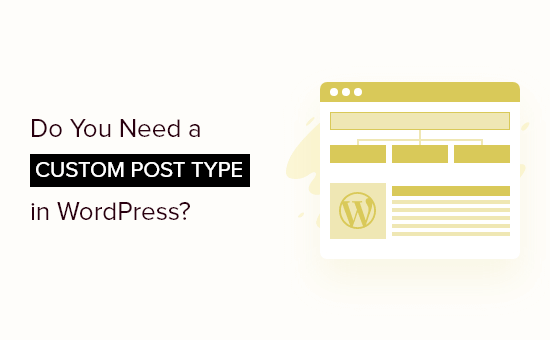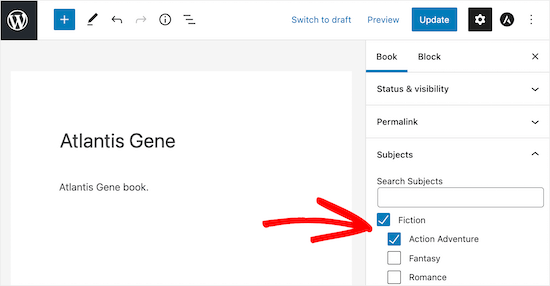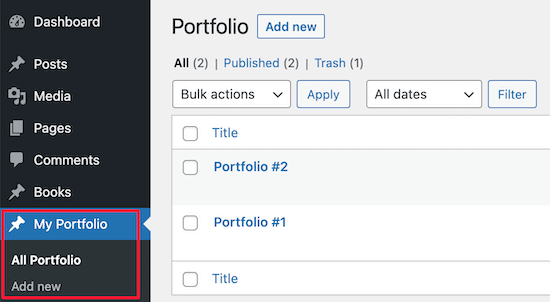Custom post types and taxonomies offer a way to extend WordPress beyond its default capabilities. Understanding when to use them in WordPress can improve your site’s organization and functionality.
These features allow you to structure your content more effectively, making it easier for users to navigate and find what they need.
This guide will help you decide when to implement these features and how to use them to their fullest potential.

What Are Custom Post Types in WordPress?
Custom post types are similar to other content types like posts and pages. A post type refers to any type of content you create on your website.
WordPress comes with a few different post types by default:
- Post
- Page
- Attachment
- Revision
- Nav Menu
- Block templates (Patterns)
- Templates
Note: There are several other content types used by WordPress behind the scenes to provide different features, such as custom CSS, customize changeset, template parts, oEmbed cache, and more.
Post types are used to help distinguish between different content types in WordPress. Posts and pages are both post types but are made to serve different purposes.
You can also create your own post types, known as custom post types. These are useful when creating content that has a different format than a standard post or page.
For example, if you run a book review WordPress website, then you will probably want to create a book reviews post type. This post type can even have different custom fields and a unique category structure.
We use custom post types at WPBeginner on our Deals and Glossary pages.

A lot of popular WordPress plugins already use custom post types to store data on your WordPress website:
- WooCommerce – Adds a ‘product’ custom post type to your WordPress site.
- WPForms – Creates a ‘wpforms’ post type to store all your forms.
- MemberPress – Adds a ‘memberpressproduct’ custom post type.
WordPress eCommerce plugins, directory plugins, real estate plugins, recipe plugins, and others also use custom post types and taxonomies for sorting content.
For more details, see our guide on how to create custom post types in WordPress.
What Are Taxonomies in WordPress?
Taxonomies are used to group posts and custom post types.
There are two taxonomies included in WordPress: categories and tags. These are useful for standard blog posts, but they may not be as suitable when you start to use custom post types.
For example, you can create a custom post type called ‘Books’ and sort it with a custom taxonomy called ‘Genre.’
Then, you can add different genres like Fantasy, Horror, Romance, Self-Help, and more. This lets you and your readers quickly sort books based on the genre they like.

For more details, see our guide on how to create custom taxonomies in WordPress.
How Do You Know When You Need a Custom Post Type or Taxonomy?
You can theoretically add any type of content in WordPress posts and sort them with categories and tags, but sometimes this is not ideal.
Below are some signs that indicate you should probably consider creating a custom post type, custom taxonomy, or maybe both working together:
- Some content you are posting just doesn’t look and feel like a post. For example, our blogging coupons page.
- Your content doesn’t need to be part of a chronological series of entries. For example, our WordPress glossary section.
- Categories and tags won’t help you group and sort that particular content. For example, the specific sections in our coupons area.
- You need additional fields to enter more information with your content. For instance, our WordPress Solution Center has different sections with custom fields.
- It cannot be part of your pages. For example, our Blueprint page is simply a page with several subpages.
- You need to display that particular content differently than posts or pages.
Now, let’s look at a real-life example. Suppose you run a movie review website where you publish movie reviews and other kinds of movie-related content.
However, your movie reviews have been very popular with your audience. You can improve your movie reviews by adding star ratings and making them searchable by actor names, genre, and more.
In this case, you will need to create a custom post type for movie reviews and then add a custom taxonomy for sorting between actors and genres.
This makes it easy for your visitors to browse through your movie reviews instead of every post on your WordPress blog.
Another typical example is for creatives like photographers and graphic designers creating portfolios.
If you simply share your work in a blog post, it’s easy to get lost in the rest of your content. By creating a separate portfolio custom post type, your visitors can easily browse through all of your work.

If you have various categories of work in your portfolio, then you can also create a custom taxonomy for each type of portfolio project.
Additional Resources
New to extending WordPress with custom taxonomies and post types? At WPBeginner, we have been helping WordPress beginners for the last 16 years.
In our experience, the following are some of the most useful resources for managing custom post types and taxonomies in WordPress:
- How to convert categories to custom taxonomies in WordPress – If you have been using categories incorrectly and now want to convert them into a custom taxonomy, then this tutorial will show you how to do that.
- How to add categories to a custom post type in WordPress – This tutorial shows how to use the default categories with any custom post type in WordPress.
- Most useful WordPress custom post types tutorials – A compilation of tutorials on using custom post types in WordPress
We hope this article helped you learn when to use custom post types or taxonomies in WordPress. You may also want to see our beginner’s guide on how to switch/convert custom post types in WordPress or our expert pick of the best popular posts plugins for WordPress.
If you liked this article, then please subscribe to our YouTube Channel for WordPress video tutorials. You can also find us on Twitter and Facebook.





Syed Balkhi says
Hey WPBeginner readers,
Did you know you can win exciting prizes by commenting on WPBeginner?
Every month, our top blog commenters will win HUGE rewards, including premium WordPress plugin licenses and cash prizes.
You can get more details about the contest from here.
Start sharing your thoughts below to stand a chance to win!
Frank Luzón says
Thank you for this article, it helped me a lot!
WPBeginner Support says
Glad our guide was helpful!
Admin
Rana says
A great article!!
So now I want to learn custom field,type & taxonomy. From where can i learn properly all of these useful things.?? Plz suggest me any blog or YT channel or anything else..
WPBeginner Support says
We have a few articles to assist, for custom fields, we have the guide below:
https://www.wpbeginner.com/wp-tutorials/wordpress-custom-fields-101-tips-tricks-and-hacks/
We also have our guide on custom taxonomies is below:
https://www.wpbeginner.com/wp-tutorials/create-custom-taxonomies-wordpress/
Admin
Amy says
Custom Post Types are awesome but something I’ve always wondered: how do you handle when or if you want to delete like for the sake of your example a ‘single coupon’ from the CPT…. like you no longer need it or it’s not relevant anymore. Does this cause an error if someone clicks on it in search results if it indeed was showing up in search results; how do you handle properly deleting a specific item from a Custom Post Type? Or maybe you don’t delete it at first; you mark it with a Redirect possible? Would love to know how that should be handled properly
WPBeginner Support says
You would delete the custom post the same you would a regular post on your site and then create a 301 redirect following our guide below:
https://www.wpbeginner.com/beginners-guide/beginners-guide-to-creating-redirects-in-wordpress/
Admin
Amy says
Ok cool, thank you! So you would do a redirect then, nice I was kinda on the right track! Thank you!!!!
arddev says
Hi, am I correct to think that your index(CT) has the same slug name as your “glossary” CPT? Is there any possible conflict when a custom taxonomy has a slug the same as a CPT?
WPBeginner Support says
We do not need a custom taxonomy for our custom post type but if your custom taxonomy has the same slug then there is a chance it can cause issues based on your permalink settings.
Admin
ADRIE says
What is “Related Post-Meta Box”?
Is that another way of saying, related post or related products?
Or related categories/tags?
WPBeginner Support says
It is a custom taxonomy
Admin
Tanuj Kalia says
Hi, I run a site, we have 14,000+ posts (all ‘just’ posts) with NO ‘custom posts’.
The website has been running for 8 years now, and we have 250,000 unique visitors a month.
We now want to convert some ‘categories’ of the posts into ‘custom posts’.
How do we ensure that our URL structure (and SEO) is not disturbed?
Thanks in anticipation!
WPBeginner Support says
For setting your custom post type permalinks so the urls remain, you would want to take a look at our article here: https://www.wpbeginner.com/plugins/how-to-change-custom-post-type-permalinks-in-wordpress/
Admin
Snippet says
Great articles for those who are starting with wordpress.. I have a question: can a taxonomy be created only for regular posts in a category/several categories? and not with a custom post type…
Steve says
I don’t know if these comments are still being monitored/responded to, but I just came across your article. I would like to do something analogous to your coupons pages, but add a feature where a reader can have an RSS feed or email notification sent to them whenever a new coupon is added to a specific category (e.g., Theme coupons, but not Plugin coupons, or vice versa). Could such features be added to a custom post type/taxonomy as a native WordPress feature or with a plugin? Thanks (for the article, and a possible reply).
WPBeginner Support says
All custom post types and taxonomies in WordPress have their own RSS feeds. This allows you to segment your email list(s). You can allow users to subscribe to your coupons post type or selected taxonomies under coupons post type.
Admin
Laila says
Thanks for great ‘plain English’ videos for non tech experts.
I don’t think I need the extras that a custom post type plug in offers. If I should change my mind later in the development and implementation is it possible (without too many headaches) to add a custom post plugin at a later date and then categorize regular posts already made?
Thanks.
WPBeginner Support says
Yes it is possible. But the difficulty level depends on what you want to do with custom post types.
Admin
Gerard says
Great explanation. I’m developing a theme and I didn’t know how to separate the Testimonials section, the Quotes section, the Portfolio section, etc. Also, I will use it in a site where I review hostings.
But I have a question about it: where is the information stored? If I make backups using a plugin, will the information be stored?
Johan says
Can I store my custom post type in a new table, like wp_products instead to wp_posts. If yes, can someone point me in the right direction? Please.